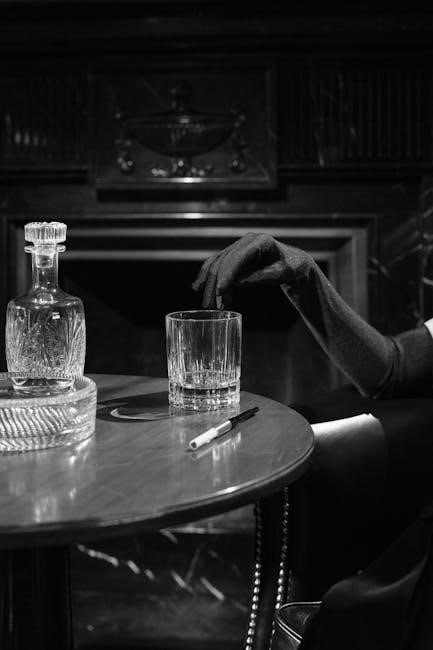Agatha Christie’s And Then There Were None is a masterclass in character-driven mystery, with a unique structure that demands careful analysis of each role in the plot.
1.1 Overview of the Novel
And Then There Were None by Agatha Christie is a gripping mystery novel about ten strangers invited to a remote island, only to be accused of past crimes. Isolated and trapped, they face a deadly reckoning. The novel’s intricate plot and psychological depth explore themes of guilt, justice, and morality. Christie masterfully weaves together diverse characters, each with secrets, creating a tense atmosphere of suspicion and paranoia. The novel’s climax is both shocking and thought-provoking, leaving a lasting impact on readers.
1.2 Importance of Character Analysis
Character analysis in And Then There Were None is crucial for understanding the novel’s intricate plot and themes. Each character’s backstory, motivations, and psychological state are meticulously crafted by Christie to reveal deeper truths about guilt, justice, and morality. By examining their interactions and development, readers gain insight into how past actions shape their present dilemmas. This analysis also highlights Christie’s mastery in creating complex, multi-dimensional characters, making the novel a timeless study of human nature and ethical dilemmas.

Main Characters in “And Then There Were None”
The novel features ten distinct characters, each with unique traits and secretive pasts, brought together on a remote island, setting the stage for a gripping tale of guilt and justice.
2.1 Anthony Marston
Anthony Marston is a young, arrogant, and reckless playboy whose charm masks a dark past. He is accused of causing the deaths of two children through his careless driving. Marston’s character represents the theme of guilt and its consequences, as he initially shows no remorse for his actions. His presence on the island forces him to confront his morality, making him a pivotal figure in the novel’s exploration of justice and redemption.
2.2 Mrs. Rogers
Mrs. Rogers, the stern and reserved housekeeper of Soldier Island, is a crucial figure in the novel. Her rigid demeanor and sharp observations contribute to the tense atmosphere. Accused of withholding life-saving medication from her previous employer, Mrs. Rogers embodies the theme of guilt and moral accountability. Her relationship with her husband, Thomas, adds depth to her character, highlighting her loyalty and the weight of shared secrets. Her actions subtly influence the unfolding mystery, making her a key player in the plot’s progression.
2.3 General Macarthur
General Macarthur, a retired military officer, is haunted by his past actions. Accused of sending his wife’s lover to his death, he carries a burden of guilt. His arrogant demeanor and rigid adherence to military discipline mask a deep-seated fear of judgment. As the mystery unfolds, Macarthur’s paranoia intensifies, revealing his internal struggle with remorse. His character serves as a poignant exploration of justice, morality, and the psychological impact of unchecked guilt, making him a pivotal figure in the novel’s intricate plot.
2.4 Emily Brent
Emily Brent, a rigid and self-righteous spinster, adheres to a strict moral code. Her unyielding religious beliefs lead her to judge others harshly, yet she harbors a dark secret. Responsible for the death of a young woman she deemed immoral, Emily’s hypocrisy is central to her character. Her refusal to acknowledge her own guilt isolates her, making her a tragic figure. This rigidity underscores her inability to seek redemption, contributing to the novel’s themes of justice and moral accountability, highlighting the consequences of unchecked judgment.
2.5 Dr. Edward Armstrong
Dr. Edward Armstrong, a respected Harley Street physician, is invited to the island under mysterious circumstances. His calm and collected demeanor contrasts with the growing tension. Armstrong’s background as a doctor adds depth to his character, as he is initially seen as a voice of reason. However, his own dark secret gradually surfaces, revealing his complicity in a tragic event. His role in the novel highlights the theme of guilt and the consequences of moral compromise, making him a pivotal figure in the unfolding drama.
2.6 William Blore
William Blore, a former police inspector, is a robust, no-nonsense individual with a military demeanor. Known as “Blore the Cat” for his survival skills, he is initially dismissive of the island’s eerie atmosphere. His practical nature and investigative mindset make him a key observer of the unfolding events. However, his own guilty past as a corrupt officer slowly surfaces, revealing a man haunted by his misdeeds. Blore’s journey from skepticism to paranoia underscores the novel’s exploration of guilt and redemption.
2.7 Vera Claythorne
Vera Claythorne is a young, athletic woman with a mysterious past. Accused of murdering Cyril Hamilton, a child in her care, Vera denies the charge but is haunted by guilt. Her determination and resourcefulness are evident as she navigates the island’s dangers. However, her reserved nature and internal turmoil make her a complex figure. Vera’s journey reveals her struggle to confront her past and her ultimate fate, making her a pivotal character in the novel’s unfolding tragedy.
2.8 Philip Lombard
Philip Lombard is a charming, adventurous ex-military officer with a murky past. Accused of murdering East African natives, he exudes confidence and a survivalist mindset. Lombard is resourceful and calculating, often taking charge in crises. His chemistry with Vera Claythorne adds depth to his character. Despite his questionable morals, Lombard’s pragmatism and strength make him a key figure in the group’s dynamics, ultimately facing a tragic end that underscores the novel’s themes of guilt and justice.
2.9 Justice Wargrave
Justice Wargrave, a retired judge, is a central figure in the novel, known for his strict moral code and authoritarian demeanor. His past involves sentencing individuals to death, which haunts him. Wargrave is revealed as the mastermind behind the island’s tragic events, orchestrating the deaths to punish those he deems guilty. His own guilt and rigid sense of justice lead to his demise, symbolizing the novel’s exploration of morality and accountability.

Themes and Motifs in the Novel

The novel explores themes of guilt, justice, and isolation, with motifs of paranoia and redemption intertwined throughout the narrative, shaping the characters’ fates.
3.1 Guilt and Redemption
Guilt and redemption are central to the novel, as each character confronts their past misdeeds. The isolated setting amplifies their internal struggles, revealing how guilt shapes their actions and decisions. Redemption, however, remains elusive for most, as their past crimes ultimately seal their fates. This theme underscores the psychological depth of Christie’s work, highlighting the enduring consequences of moral failure and the quest for forgiveness, even in the face of inevitable judgment.
3.2 Justice and Morality
Justice and morality are explored through the characters’ deaths, each designed to mirror their past wrongdoings. The novel challenges traditional notions of justice, suggesting a higher moral reckoning beyond human law. The characters’ fates raise questions about the nature of morality, whether true justice can be achieved, and the role of guilt in shaping ethical decisions. This theme adds complexity to the narrative, inviting readers to reflect on their own moral frameworks and the consequences of their actions.
3.3 Isolation and Paranoia
The novel masterfully employs isolation to heighten paranoia among the characters. Stranded on a remote island, they become increasingly suspicious of one another, fueling psychological tension. Christie uses the confined setting to explore how isolation erodes trust, leading to desperate actions and self-doubt. This theme underscores the fragility of human psychology when external pressures intensify, making it a pivotal element in the novel’s suspenseful unraveling and character breakdowns.
Creating a Character Chart for “And Then There Were None”
A character chart for And Then There Were None organizes each character’s details, enabling a clearer understanding of their roles, interactions, and developmental arcs within the story.
4.1 Structure of the Chart
The character chart should include columns for Character Name, Background, Motivations, Conflicts, and Development. This structure helps track each character’s journey and relationships, providing a visual guide to their roles in the plot.
4.2 Key Elements to Include
Each entry should detail the character’s background, motivations, conflicts, and development. Including quotes and symbolism can enhance understanding. Visual elements like color-coding or relationship arrows can highlight connections and themes, making the chart a comprehensive tool for analysis.
Analyzing Character Relationships
Examine how alliances form and suspicions rise among the characters, driving the plot’s tension. Analyze their psychological interactions and how these relationships reveal deeper motives and fears.
5.1 Dynamics Between Characters
The novel’s tension arises from complex character interactions, as alliances form and suspicions grow. Vera and Lombard’s mutual distrust contrasts with General Macarthur’s authoritarian presence. Mrs. Rogers’ subdued nature clashes with the assertive Dr. Armstrong, while Justice Wargrave manipulates others through his calm demeanor; These dynamics reveal psychological depths, as characters confront their pasts. Christie masterfully uses these relationships to build suspense, ensuring each interaction propels the plot toward its climactic revelation. The character chart aids in mapping these evolving connections and their role in the story’s progression.
5.2 Role of Each Character in the Plot
Each character in And Then There Were None plays a pivotal role in unraveling the mystery. Vera Claythorne’s resilience contrasts with Justice Wargrave’s calculating nature, while Dr. Armstrong’s medical expertise and Philip Lombard’s resourcefulness are central to the plot. The characters’ dark pasts and secrets drive the narrative, as their actions and decisions dictate the unfolding events. A character chart effectively maps these roles, highlighting how each individual’s backstory and choices contribute to the novel’s tension and ultimate resolution.

The Significance of the Character Chart in Understanding the Novel
A character chart visually organizes the intricate relationships and traits, offering clarity on how each role contributes to the plot’s tension and thematic elements.
6.1 Visual Representation of Characters
A character chart provides a clear visual map of each character’s traits, backstory, and relationships, enhancing understanding of their roles in the novel’s complex web of guilt and justice.
6.2 Tracking Character Development
The character chart effectively tracks development by illustrating how each character’s traits, motivations, and interactions evolve throughout the novel. As the story unfolds, the chart reveals the psychological unraveling of characters under isolation, highlighting their hidden pasts and moral dilemmas. This visual tool allows readers to observe the gradual breakdown of facades, making the characters’ ultimate fates more understandable and the novel’s themes of guilt and justice profoundly impactful.
The character chart enhances understanding of And Then There Were None, offering insights into Christie’s exploration of justice, guilt, and human complexity through meticulously crafted characters.
7.1 Final Thoughts on Character Analysis
Character analysis in And Then There Were None reveals Christie’s mastery of psychological depth. Each character’s guilt and redemption arc is meticulously crafted, offering insights into human morality. The novel’s structure, isolating characters on an island, amplifies their inner conflicts and paranoia. Through their interactions and eventual demise, Christie explores themes of justice and the consequences of past actions. A character chart serves as a vital tool to track these dynamics, enriching the reader’s understanding of the plot’s intricate layers and the author’s intent.
7.2 Relevance of the Character Chart for Readers
A character chart for And Then There Were None is an invaluable resource for readers, providing a visual map of each character’s role, motivations, and connections. It simplifies the complex web of relationships and secrets, making the novel’s intricate plot more accessible. By organizing details like backstories, crimes, and suspicions, the chart enhances comprehension and engagement. This tool not only aids in tracking the mystery but also deepens the reader’s appreciation of Christie’s masterful storytelling and the psychological depth of her characters.

